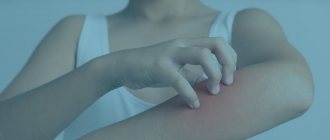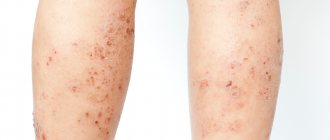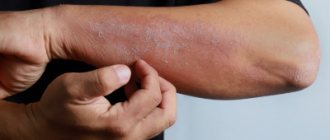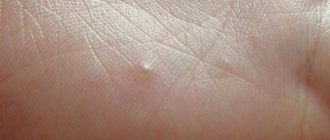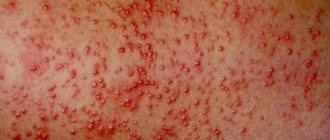| Appointment with a dermatologist at the clinic. Call a dermatologist at home. | Reception is strictly by appointment, make an appointment by phone: +7 | Prices for services | Reviews about the clinic |
Itching between the buttocks characterizes a localized state of irritation of the dermis or tissues of the final intestine, including the sphincter zone. The condition develops against the background of various directions of pathological influence, which subsequently, with a protracted course, manifests itself in the form of a general psycho-emotional disorder.
The feeling of irritation in the anus is a limited expression of the body's reaction, signaling the development of a pathological disorder associated with a functional deviation in its activity. A dermatologist will help determine the cause of the imbalance by conducting the necessary cycle of examination procedures, which makes it possible to use targeted therapeutic actions, eliminating the cause of the disease.
Make an appointment with a dermatologist by phone or by filling out the online form
| Select a clinic | Skin rash | Dermatologist | Dermatologist at home |
Answers to frequently asked questions about itchy skin:
- Which doctor treats itchy skin?
- What organs are affected by skin itching?
- Why is itchy skin dangerous?
- What tests should be taken for itchy skin?
- What diet is needed for itchy skin?
- What diseases does itchy skin indicate?
- Itchy skin for no apparent reason?
- What parasites cause itchy skin?
- What microorganisms cause itchy skin?
- How to get rid of itchy skin?
- Should a patient with itchy skin be isolated?
- Skin itching due to gastrointestinal diseases?
- What are the main causes of itchy skin?
- How to distinguish allergic itching from parasitic itching?
- How to prepare for an appointment with a dermatologist?
- How to get checked for skin diseases?
- What diseases does a dermatologist treat?
- What tests should be taken by a dermatologist?
- What diagnostics can a dermatologist perform in the clinic?
- Where to go with a skin disease?
Causes of itching
Itching of the buttocks in adults can be caused by various reasons, the most common of which are:
- Excessive drying of the skin is due to the fact that there are no sebaceous glands on the buttocks. This part of the body is regularly in contact with irritants such as chairs and the sofa. In addition, it receives less oxygen, since it is constantly in contact with underwear, which creates favorable conditions for the development of itching and acne.
- Physical inactivity often leads to this problem. Usually people leading an active lifestyle do not have such problems.
- If a person has problems with self-cleansing skin, this is often a problem for them. This is due to the fact that dead cells do not fall off, but remain on the skin, causing itching.
- Hormonal imbalances can lead to itching of the buttocks in women.
- Synthetic, tight-fitting underwear.
- Allergic reaction to detergents, detergents.
- Cooling was created by sitting on a cold surface.
Additionally, these symptoms may develop as a result of certain medical conditions, such as:
- Liver disorders.
- Endocrine disorders.
- Infection of the body with helmets that irritate the passages of the anus, as a result of which the person experiences itching on both the right and left buttocks at the same time.
- Skin diseases.
- Inflammatory processes that occur on the external genitalia.
- The inflammatory process of the rectal mucosa usually develops in lovers of spicy food. This condition also occurs in people who take medications for a long time.
- Anal injury.
- Infectious processes affecting the genitals.
A dermatologist can determine the exact cause of the disease after examination.
Symptoms of eczema on the buttocks
Eczema in the lower back and between the buttocks has a number of characteristic symptoms, as shown in the photo.
- Small spots, bumps, blisters in the butt area and around the anus,
- Bubbles in the anal area,
- Itching, which intensifies at night and also becomes more intense when the patient scratches the affected areas,
- Red, irritated, swollen spots,
- Blisters and bubbles burst, a clear liquid flows out of them, which dries in the form of yellowish crusts covering the affected area,
- Dryness and flaking in some areas,
- Redness and irritation in the intergluteal fold,
- Soreness and itching around the anus,
- Pimples, acne-like rash,
- The ulcerated areas are tender and painful to touch.
Let's consider what distinctive features allow us to distinguish types of epithelial lesions on the buttocks of different origins.
Contact dermatitis is quite common. It develops when the skin of the body comes into direct contact with an irritating substance. Sometimes the reaction occurs immediately after contact, while in other cases some time passes between exposure to the irritant and the appearance of skin changes. Allergens and irritating chemicals cause damage to the skin. The manifestations of the pathology are similar to other types of eczema, but there are a number of distinctive features. So, with this type of dermatitis, the rash is accompanied not so much by the desire to itch, but by pain, which can be very pronounced, especially with dermatitis of an allergic nature. Another important symptom is the location of the rash: this is exactly the area of the body that came into contact with the trigger. For example, if irritation occurs from a cosmetic product, the epithelium will be affected only where this product was applied. Clear boundaries and a certain shape of the irritation zone distinguish contact dermatitis from other skin diseases. If the contact allergen is any type of food, food additive or medicine in the form of tablets, eczema of the mucous membranes of the digestive system develops, and the first symptom is itching of the anus, and then rashes in the perianal area join (see photo), and therapy for this condition is the same as the treatment of contact dermatitis of any other localization.
Atopic dermatitis is a hereditary disease, the development of which involves various factors. The disease affects the gluteal region only in rare cases, in severe cases, when it spreads to the whole body. Dryness, itching and scratching are very common in this form of eczema.
Heat rash is a common type of irritation that also occurs on the butt. The most characteristic features of prickly heat are redness and burning. The skin feels tingling, itching, small red spots and pimples appear. The buttocks, inguinal and intergluteal folds are prone to this condition, as they are rich in sweat glands, and also sweat profusely because they are always covered with clothing. The ducts of the sweat glands become blocked, trapping the sweat under the skin and causing symptoms. Friction in the folds also contributes to the formation of heat rash.
Genital herpes is a viral disease that is sexually transmitted. The virus causes skin damage that looks like eczema, is located on the butt, inner thighs, around the anus, and if it appears during pregnancy, it can lead to serious consequences for the child, so it is important to consult a doctor who will tell you how to treat this disease. The rash begins in the area where the infection has entered the body, but spreads when scratched. Pain and itching, small red bumps appear, which turn into whitish blisters filled with clear liquid. Then the blisters burst, ulcers form, become wet and crust over.
Shingles is also a viral disease that is caused by the chickenpox virus. If a person had chickenpox as a child, during life, with a decrease in immunity, he may experience pain, numbness or a burning sensation in a certain segment of the body, and the buttocks are often affected. Then bubbles appear in this area, which, when opened, lead to ulcers. Itching is characteristic. This disease also has common symptoms: malaise, chills and high fever.
Diaper rash usually affects skin folds where sweating and friction occur, and bacteria and fungi grow. Inguinal folds, especially in obesity, and the fold between the buttocks are a favorite location for diaper rash. The epithelium becomes glossy, swollen, reddish, and in severe cases, cracks and bleeding appear. Characterized by pain and unpleasant odor.
A fungal infection in the groin folds, buttocks, genitals, and inner thighs develops with frequent sweating and poor personal hygiene. Athletes are very susceptible to this condition. The rash appears as pink, itchy spots and rings. Hair is lost at the site of the lesion.
Atrophic sclerosis of the skin, or lichen, occurs in postmenopausal women. It forms on the genitals, but can spread to the perianal area and buttocks. Smooth, glossy white spots appear. The skin becomes wrinkled, thins and is easily damaged, leading to bleeding. Characterized by pain and itching, as well as pain when urinating, defecating or during sex.
Folliculitis is a condition where pimples appear on the skin. Unlike facial acne, butt acne comes from clogged hair follicles. The follicles become inflamed from constant irritation (for example, from shaving or from rubbing clothes).
Candidiasis is an infection caused by the fungus candida albicans, which prefers warm and moist conditions, which forms in the buttock area. This is the most common cause of diaper rash in infants. Candidiasis also often affects diabetics, people with weakened immune systems, and those taking antibiotics.
Diaper dermatitis is a special form of eczema in infants. Skin irritation from urine, allergies to care products, washing powder or diapers, as well as infection (candida or bacterial) play a role in the development of this pathology. The main symptom is redness, irritation, swelling of the skin under the diaper: on the buttocks, pubic area and inner thighs. The child becomes restless, cries often and sleeps worse.
What not to do
In order not to aggravate the situation, you need to know what to do; doing this is not recommended. First of all, you should not self-medicate and buy medications following the recommendations of the pharmacist at the pharmacy. Since incorrectly prescribed treatment can cause an allergic reaction, thereby worsening the person’s condition. In addition, there is no need to squeeze pimples on the buttock, as this can lead to infection and the development of secondary skin infections. If it bothers you or a pimple in contact with the surface itches, it can be disinfected and pierced with a sterile needle. Then treat with alcohol and apply a patch and ointment.
Treatment of eczema on the buttocks
Different medications are effective for different forms of eczema. The doctor must diagnose and explain how to treat eczema and rashes on the butt of various origins. It is important to remember that medications that help with one type of dermatitis can worsen another type, so you should not self-medicate.
Treatment of eczema on the buttocks with medications
- Ointments and creams with glucocorticoids have an anti-inflammatory effect, eliminate symptoms and promote skin healing,
- Antihistamines help cope with itching and allergies,
- Moisturizing lotions enhance the protective function of the skin and restore the integrity of the epithelium,
- Antifungal drugs act on the underlying cause of the disease in fungal infections, thrush, diaper dermatitis,
- Antibiotics are prescribed for folliculitis, in the development of which the bacterium staphylococcus plays a major role,
- Antiviral medications help with herpes and shingles.
First aid
To get rid of the rash and itching, you should visit a dermatologist. A specialist can make the correct diagnosis by determining the nature of the condition. However, before visiting a doctor, the following recommendations will help alleviate the condition:
- Take a shower at least 2 times a day with baby soap. During an exacerbation, it is forbidden to use loofahs and thickets. After the procedure, the skin should be soaked with cotton wool moistened with calendula tincture.
- Fucorcil can also be applied to the skin after a shower with a cotton swab. Before going to bed, you should lubricate your skin with Schinoren.
- Relaxes the feeling of swimming, sauna, visiting a solarium.
- Women are advised to give up thongs, as they literally begin to crumble on the skin.
- It is best to use natural swimming trunks as underwear.
- If the patient leads a sedentary lifestyle, a small warm-up is required every 30 minutes, which is useful for improving blood circulation.
- To dry out the rash, it is recommended to apply iodine to the rash.
- If the body begins to itch, then a sitz bath with a decoction of herbs such as chamomile, string, and celandine will help relieve this feeling.
Treatment of itching
Itching of the buttocks and buttocks is a rather unpleasant symptom that requires medical attention. Usually, in order to cure a pathology, an integrated approach is required, which also includes drug treatment. First of all, it is necessary to take antihistamines that relieve the allergic nature of ailments. Eliminate itching, swelling, and rash. If the pathology does not have a clear clinical picture, then this method is usually sufficient to relieve itching and rash, provided that the cause of the discomfort is eliminated. Most often, this requires the appointment of Suprastin, Fenistil, Zodak.
In the uncomplicated stage, it is recommended to use non-hormonal topical agents, such as zinc ointment, Bepanten, Baziron, Mirastin. They eliminate irritation, soothe itching, swelling, get rid of microorganisms without drying out the skin, and nourish it. The rash can be dried with salicylic ointment 1 hour before applying the ointment. Please note that all ointments should be applied to clean skin. On the first day the rash appears, you can treat it with an iodine solution.
If itching and rash on the buttocks persist for a long time, the doctor may prescribe hormonal ointments that perfectly relieve inflammation. For this, the doctor recommends using Fucicort, Akriderm, Advant.
Methods of treatment with traditional methods
In addition, to calm the patient from itching, it is recommended to take sedatives that will help bring the nervous system into order. Most often it is Novopassit, Motherwort, tincture of valerian. To completely eliminate symptoms, a complete examination of the body is necessary. It is possible that the reasons lie in the work of internal organs. After this, treatment of the underlying condition will be required to prevent the itching from recurring.
Traditional medicine often comes to the aid of people suffering from itchy buttocks. However, you should consult your doctor before using it to avoid worsening your overall health. To eliminate irritation, soothe the skin, wash with bay leaf, lemon balm, mint, and chamomile. Mix all ingredients in equal proportions. Take 1 tablespoon of the resulting harvest, pour 1 liter of boiling water. In addition, barley will help relieve irritation: it is not bad, it relieves itching, eliminates rashes, and nourishes the skin. Pour the product into ½ kilogram of flax seeds, add 2 liters of water and cook for 1.5 hours.
If the body itches, then nettle leaves will help get rid of the itching. Pour boiling herbs and leave for 48 days, after cleansing, rinse the skin with clean water.
Diet for itching on the buttocks
Baking soda has long been known for its anti-adhesive properties. Can be used as a compress and bath. In combination with topical methods, it is recommended to take sedative herbs such as lemon balm, mint and matrix.
Treatment of itching will not give the desired result without following a special diet. The diet should be adjusted by the attending physician depending on the cause of skin irritation. Typically, the diet consists of low protein foods and hypoallergenic foods. Allowed foods include cereals, pasta, lean meat and fish, dairy products, organ meats, fresh vegetables and fruits that are not red. Compotes and a decoction of rose hips will help restore the vitamin balance. Mineral water with the release of gases helps restore the acid-base balance and remove toxins from the body.
4.Treatment
Itching in the perineum is not a disease, but only a symptom, and most often not the only one. Accordingly, desensitizing (reducing the sensitivity of skin receptors), anti-inflammatory, analgesic drugs have an auxiliary value and are prescribed symptomatically. The main goal is to find and eliminate the underlying disease, its causes and risk factors. Based on the diagnostic results, a course of etiopathogenetic therapy is prescribed: antiparasitic, antibiotic and/or antimycotic, in some cases psychotherapeutic, hormonal, proctological, etc. If a reliable cause-and-effect relationship is identified between itching in the perineum and the mechanical, chemical, and allergic factors described above, a full therapeutic effect is possible only if contact with such irritants (irritants) is excluded.
Prevention of itching on the butt
Foods that cause allergic reactions such as nuts, chocolate, coffee, citrus fruits, ginger, red fruits and vegetables should be reduced or eliminated completely. It is necessary to exclude the consumption of smoked, fried, pickled, salty and sweet foods, since itching on the buttocks often develops due to problems with the functioning of the intestines.
- As you know, it is better to prevent diseases than to treat them later, and itching too. Simple rules will help prevent skin irritation.
- It is worth making a choice in favor of natural linen;
- From sedentary work you need to do a warm-up every 30 minutes;
- A bath with a birch broom gives a good effect;
- Increased sweating is recommended when using baby powder;
- netoni wear tight clothes;
- Use scrubs at least once a week to clear clogged pores;
If you sit on a hard surface a lot, you'll need to use a soft cushion to soften the contact.
